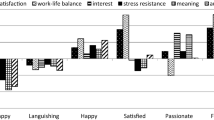Abstract
This paper presents evidence for regarding well-being and ill-being as distinct, although not orthogonal dimensions. It is suggested that well-being and ill-being may be like measures of quantitative and verbal ability in intelligence tests. For some purposes (e.g. for admitting students to particular courses of study) it may be sensible to use only one of the measures. For other purposes a combined measure-I.Q.-is appropriate. In this study we employ Indices of Well-Being and Ill-Being and a combined measure, Balance of Well-Being and Ill-Being.
Using data from the first wave (1981) of an Australian panel study (N=942), four measures of well-being and three measures of ill-being were factor analysed, confirming the existence of distinct dimensions. The value of the distinctions was underlined by findings indicating that well-being and ill-being have different correlates and causes. Wellbeing depends more than ill-being on the personality traits of extraversion and optimism, and also on the existence of supportive social networks. Ill-being is more strongly related to SES, poor health and low scoring on the trait “personal competence”,. Overall, however, it was found that more variance can be accounted for in the Balance of Well-Being and Ill-Being Index than in the separate indices of Well-Being and Ill-Being.
Similar content being viewed by others
Bibliography
Alwin, D. F. and Hauser, R. M.: 1975, ‘The decomposition of effects in path analysis’, American Sociological Review 40, pp. 37–47.
Andrews, F. M. and Inglehart, R.: 1978, ‘The structure of subjective well-being in nine Western societies’, Social Indicators Research 6, pp. 73–90.
Andrews, F. M. and McKennell, A. C.: 1980, ‘Measures of self-reported well-being’, Social Indicators Research 8 (June), pp. 127–156.
Andrews, F. M. and Withey, S. B.: 1976, Social Indicators of Well-Being (Plenum, New York).
Atkinson, T.: 1982, ‘The stability and validity of QOL measures’, Social Indicators Research 10, pp. 113–132.
Block, M. and Zautra, A.: 1981, ‘Satisfaction and distress in a community: a test of the effects of life events’, American Journal of Community Psychology 9 (1981), pp. 165–180.
Bradburn, N. M.: 1969, The Structure of Psychological Well-Being (Aldine, Chicago).
Brown, G. W. and Harris, T.: 1978, Social Origins of Depression (Tavistock, London).
Campbell, A., Converse, P. E., and Rodgers, W. L.: 1976, The Quality of American Life (Sage, New York).
Campbell, A.: 1981, The Sense of Well-Being in America (McGraw-Hill, New York).
Cobb, S.: 1976, ‘Social support as a mediator of life stress’, Psychosomatic Medicine 38, pp. 300–314.
Costa, P. T. and McCrae, R. R.: 1980, ‘Influence of extraversion and neuroticism on subjective well-being’, Journal of Personality and Social Behavior 38 (4), pp. 668–678.
Dohrenwend, B. S. and Dohrenwend, B. P. (eds.): 1974, Stressful Life Events: Their Nature and Effects (Wiley, New York).
Dohrenwend, B. S. and Dohrenwend, B. P.: 1978, ‘Some issues in research on stressful life events’, Journal of Nervous and Mental Disease 166, pp. 7–15.
Eysenck, H. J. and Eysenck, S. B. G.: 1977, Personality Structure and Measurement (Routledge and Kegan Paul, London).
Fox, J.: 1980, ‘Effect analysis in structural equation models’, Sociological Methods and Research 9, pp. 3–28.
Headey, B. W.: 1981, ‘The quality of life in Australia’, Social Indicators Research 9 (1981), pp. 155–182.
Headey, B. W. and Wearing, A. J.: 1981, Australians' Priorities, Satisfactions and Well-Being (DCWS and Melbourne University, Melbourne).
Headey, B. W., Holmström, E. L. and Wearing, A. J.: 1982, Australians' Priorities, Satisfactions and Well-Being: Methodological Issues (DCWS and Melbourne University, Melbourne).
Henderson, S., Byrne, D. G., and Duncan-Jones, P.: 1981, Neurosis and The Social Environment (Academic Press, Sydney).
Holmes, T. H. and Rahe, R. H.: 1967, ‘The social readjustment rating scale’, Journal of Psychosomatic Research qq, pp. 213–218.
Jahoda, M.: 1958, Current Conceptions of Positive Mental Health (Basic, New York).
Kish, L.: 1965, Survey Sampling (Wiley, New York).
Levinson, D. J., et al.,: 1978, The Seasons of a Man's Life (Knopf, New York).
Lin, N., et al.: 1979, ‘Social support, stressful life events and illness’, Journal of Health and Social Behaviour 20, pp. 108–119.
Michalos, A. C.: 1979, ‘Life changes, illness and personal life satisfaction in a rural population’, Social Science and Methodology 13A, pp. 175–181.
Michalos, A. C.: 1980, ‘Satisfaction and happiness’, Social Indicators Research 8, pp. 385–422.
Michalos, A. C.: 1982, ‘The satisfaction and happiness of some senior citizens in rural Ontario’, Social Indicators Research 11, pp. 1–30.
Mueller, D. P., Edwards, D. W., and Yarvis, R. M.: 1977, ‘Stressful life events and psychiatric symptomatology: change or undesirability’, Journal of Health and Social Behaviour 18.
Paykel, E. S., Prusoff, B. A., and Uhlenhuth, E. H.: 1971, ‘Scaling of life events’, Archives of General Psychiatry 25, pp. 340–347.
Pearlin, L. I. et al.: 1981, ‘The stress process’, Journal of Health and Social Behaviour 22, pp. 337–356.
Selye, H.: 1956, The Stress of Life (McGraw-Hill, New York).
Selye, H.: 1971, ‘The evolution of the stress concept’, in L. Levi (ed.), Society, Stress and Disease Vol. I (Oxford U.P., London).
Sheehy, G.: 1981, Pathfinders (Bantam, New York).
Srole, L., et al.: 1962, Mental Health in the Metropolis, Vol. I (McGraw-Hill, New York).
Vaillant, G.: 1977, Adaptation to Life (Little and Brown, Boston).
Veroff, J., Douvan, E., and Kulka, R. A.: 1981, The Inner American (Basic, New York).
Author information
Authors and Affiliations
Additional information
For their advice and comments we would like to thank Frank M. Andrews of the University of Michigan, Colin Benjamin of the Department of Employment and Training, Victoria, Johnathan Kelley of Australian National University, Melvin L. Kohn of the National Institute of Mental Health, Washington D.C., Michele Levine of the University of Melbourne, Susan Payne of the University of Queensland and Willard L. Rodgers and Lois Verbrugge of the University of Michigan. Our thanks are also due to the following institutions for research support: The Australian Research Grants Scheme, the Department of Community Welfare Services, Victoria and the University of Melbourne.
Rights and permissions
About this article
Cite this article
Headey, B., Holmström, E. & Wearing, A. Well-being and ill-being: Different dimensions?. Soc Indic Res 14, 115–139 (1984). https://doi.org/10.1007/BF00293406
Received:
Issue Date:
DOI: https://doi.org/10.1007/BF00293406




